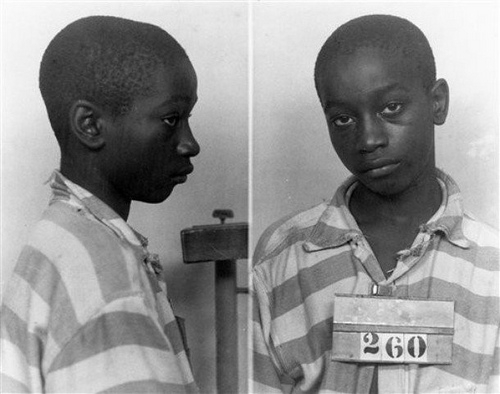Killing Children in the U.S.: The Case of George Stinney

An anonymous person e-mailed me about a young man named George Stinney. I had never heard of his story before. More on young Mr. Stinney soon.
It’s hard to believe that it wasn’t until 2005 that the U.S. Supreme Court overturned the juvenile death penalty by ruling that killing individuals who had committed their crime before age 18 was cruel and unusual punishment. Way before 2005, there was a growing consensus across the world that the death penalty was not acceptable as a form of punishment for children. Between 1990 and 2000, the executions of children had been documented in only six countries: Iran, Nigeria, Pakistan, Saudi Arabia, the United States, and Yemen. Enough said…
Thomas Graunger was the first person executed for a juvenile crime in 1642. Since then, the U.S. executed 365 people who committed juvenile crimes. Click here for a list of the individuals who were executed for crimes that they had committed as juveniles in the modern era. In a number of modern-day cases, youth who had been sentenced to death in the United States were mentally impaired. A study found that all 14 U.S. juvenile offenders sentenced to death in 1988 had suffered serious head injuries during their childhoods. All 14 suffered from psychiatric disorders (Amnesty International).
One of the other major issues about the U.S. juvenile death penalty was that it was racist. Two-thirds of juveniles who were on death row were from minority racial groups, and most of their alleged victims were white. This brings me back to the case of George Stinney. The story that I read about him begins this way:
In a South Carolina prison sixty-six years ago, guards walked a 14-year-old boy, bible tucked under his arm, to the electric chair. At 5′ 1″ and 95 pounds, the straps didn’t fit, and an electrode was too big for his leg.
The switch was pulled and the adult sized death mask fell from George Stinney’s face. Tears streamed from his eyes. Witnesses recoiled in horror as they watched the youngest person executed in the United States in the past century die.
Stinney was of course Black and today a man named George Frierson is fighting to clear the boy’s name charging that the state killed the wrong person. Unfortunately, the story is a familiar one.
Stinney was accused of killing two white girls, 11 year old Betty June Binnicker and 8 year old Mary Emma Thames, by beating them with a railroad spike then dragging their bodies to a ditch near Acolu, about five miles from Manning in central South Carolina. The girls were found a day after they disappeared following a massive manhunt. Stinney was arrested a few hours later, white men in suits taking him away. Because of the risk of a lynching, Stinney was kept at a jail 50 miles away in Columbia.
Stinney’s father, who had helped look for the girls, was fired immediately and ordered to leave his home and the sawmill where he worked. His family was told to leave town prior to the trial to avoid further retribution. An atmosphere of lynch mob hysteria hung over the courthouse. Without family visits, the 14 year old had to endure the trial and death alone.
Apparently, George Stinney confessed to the crime, the trial lasted 3 hours and the all-white jury came back with a guilty verdict in 10 minutes. Anyone interested in learning more about this case can listen to this NPR Story which interviews family members of Stinney and also of one of the young women who was murdered.
Our history is replete with cases like these. Most of them are committed to obscurity. I am grateful to the stranger who shared the story of young George Stinney with me and I am proud to pass it on…
Update:
Someone e-mailed this harrowing clip from a film called “Carolina Skeletons” depicting the killing of George Stinney. It is a dramatization of events and it is heartbreaking.
